June 30, 2009

VARIAN Inc
in Yarnton
near Oxford (UK)
The new NMR
Headquarters?
| Quo vadis, Varian?
During the last months there were mounting indications that the NMR activities of Varian Inc, one of the three major manufacturers of high-resolution NMR spectrometers, were being (again!) deeply reorganized. Varian is not new to major re-organizations (read this). There was even a period in its history, back around 1980, when the top management of the then Varian Associates decided they could do without NMR and dropped out from the market, only to return laboriously back a few years later (their ESR branch was not so lucky; it was dismissed permanently). Other traumatic reorganizations accompanied the moves of the Varian NMR headquarters from Zürich to Zug (both in Switzerland) and then to Darmstadt (Germany), and upon each such reorganization some valuable NMR scientists were shed or moved away (Warren Proctor, Jim Hyde, Felix Wehrli, and Tony Wirthlin are just a few names that come to mind in this connection).
Given this track record, it is not surprising that Varian NMR User community became a bit jittery in recent months when it became clear that yet another "European" reorganization was under way and the headquarters would move once again, this time from Darmstadt to Yarnton, a small place close to Oxford (UK), leaving in Darmstadt just a commercial office, more limited in scope even compared to the one Varian keeps, for example, in Milan (Italy).
I does appear, however, that this time the changes make sense (at least from the Company's point of view). The NMR operations are nowadays part of Varian Inc, one of the three Companies which originated from the 1999 split of the once glorious but not always profitable Varian Associates (all in Palo Alto, California). In recent years, Varian Inc has invested a lot into Magnex Ltd, a producer of superconducting magnets based in Yarnton, UK, and specializing in devices for high-resolution NMR spectroscopy. Finally, earlier this year, Magnex was fully absorbed by Varian Inc and disappeared as an independent name.
Now, the premises of ex Magnex in Yarnton are huge - comparable to those of Varian Inc in Palo Alto. The weight of Yarnton in terms of personnel must be also quite considerable because, with its approximate total count of 3600, Varian Inc is not really particularly big. Take also into account that many Varian NMR research and development activities were already centered in Yarnton (the name of Erik Kupce is certainly a valid testimony for this statement). Finally, add the fact that the Director of Varian Inc NMR is Thomas De Swiet, an Englishman from the same area, and the picture becomes clear. What is happening is that i) Varian Inc has quite reasonably made Yarnton the headquarters of its European activities and "discontinued" Darmstadt and ii) Yarnton is becoming the headquarters of all its NMR activities, essentially moving its NMR barycenter from California to the UK.
The particular NMR Users whom I found quite worried were from Bohemia (I met them on the 24th Valtice NMR Central-European meeting which, for the first time in its history, was not sponsored by Varian). From the above, however, I feel that their worries are excessive. While it is true that the Yarnton headquarters are kind of in the middle of deep English countryside and not as easy to access as Darmstadt, we live in a world where groups of English youngsters find it economically convenient to hop on a cheap Ryan Air flight for a beer-drinking night in Prague. So, perhaps, the travel is not such a bit concern, provided that the overall operation gains in quality.
It is more difficult for me to understand whether the Varian NMR Users in North America have more reasons to be worried than those in Prague. Perhaps a tranquilizing comment from the Company would not be a bad idea. Especially since what I wrote above is based just on my impressions. I talk with people, but I am no industrial analyst and my impressions need not be exactly the golden truth.
If interested, take a look at Varin Inc (VARI) stock performance charts.
|
June 13, 2009
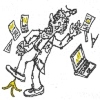
He did NOT use
UpenWin!
(home page)
MANUAL
Online
ORDER Form
Output example
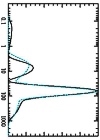
| Continuous Inverse Laplace Transform with UpenWin
The field of Inverse Laplace Transform (ILT) is a thorny one, plagued as it is by many metropolitan myths and misconceptions. The basic goal is the decomposition of decay curves into their presumably independent exponential-decay components. The problem is that the numeric math associated with such an inversion is always severely ill-conditioned and - no matter what inversion method has been used - the results are prone to exhibit unrealistic features due to minor experimental noise excursions.
This calls for methods which impose additional a-priori constraints on the domain of admissible target functions. Such constraints - often called regularizations - can be of a purely mathematical nature, such as the cutoff threshold in singular value decomposition (SVD) techniques, or they can be based on an extensive body of experience in a particular field. The latter approaches are usually the best ones within their specific application areas.
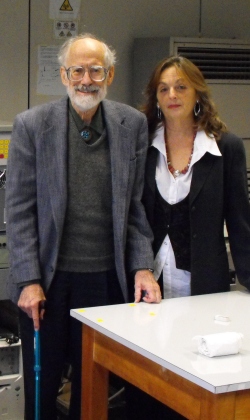
UpenWin is a moderately priced Windows software package which addresses the ILT problem in cases where one can expect a continuous distribution of decay rates spread over broad intervals covering one to five orders of magnitudes. It evolved from an older DOS program developed by Robert J. S. Brown (Bob), Paola Fantazzini, and the late G. Cesare Borgia which was originally intended for NMR applications in petrology but later frequently applied to biological systems.
The regularization consists in this case in keeping the log-scale second derivative of the resulting decay-rate distribution function as low as possible, while maintaining a good quality of the fit of the experimental decay data.
The name UPEN stands for "uniform penalty" and the approach belongs to the category known as least-squares optimization with penalty. The input data typically consists of [at least] 128 logarithmically distributed decay-curve points and the output is a decay-rate probability distribution function, typically with 128 points spread logarithmically over 2 to 5 orders of magnitude (Nepers). The algorithm itself has been published a long time ago; it stems from Bob's decades-long experience with NMR relaxometry in porous media at Chevron Corporation, and from his later work with Cesare and Paola. The DOS version of UPEN has for a long time circulated informally among friends. Now Bob, together with Villiam Bortolotti of DICMA, have wrapped it up as a Windows package available through the University of Bologna commercial services.
The package is eminently suitable to assess broad distributions of decay rates, such as those of T1 and T2 encountered in wet porous solids, vegetable and animal tissues, and other highly complex systems. It is extremely robust with respect to experimental noise and data imperfections. Due to its typical resolution of about 0.3 - 0.5 Neper, however, it is not optimal for systems with just a few relatively closely spaced decay components.
Note: The photo of Bob Brown and Paola Fantazzini shown above was taken by myself on 25 November 2008 at the Physics Department of the University of Bologna (Italy). Bob is retired and lives in California, but he collaborates with Paola's group and visits Bologna quite often. Paola has a Chair at the Physics Department and, together with Villiam, manages also the MRPM Lab (Magnetic Resonance in Porous Media) which kicked-off the first MRPM Bologna Conference, now an international bi-annual NMR event.
References:
- Borgia G.C., Brown R.J.S., Fantazzini P.,
Uniform Penalty Inversion of Multiexponential Decay Data,
J.Magn.Reson. 132, 65-77 (1998).
DOI link
- Borgia G.C., Brown R.J.S., Fantazzini P.,
Examples of Uniform Penalty Inversion of Multiexponential Decay Data,
Magn.Reson.Imaging 16, 549-552 (1998).
DOI link
- Borgia G.C., Brown R.J.S., Fantazzini P.,
Estimates of permeability and irreducible water saturation by means of a new robust computation of fractional power average relaxation times,
Magn.Reson.Imaging 16, 613-615 (1998).
DOI link
- Borgia G.C., Brown R.J.S., Fantazzini P.,
Uniform Penalty Inversion of Multiexponential Decay Data II. Data Spacing, T2 Data, Systematic Data Errors, and Diagnostics,
J.Magn.Reson. 147, 273-285 (2000).
DOI link
- Borgia G.C., Brown R.J.S., Fantazzini P.,
Examples of marginal resolution of NMR relaxation peaks using UPEN and diagnostics,
Magn.Reson.Imaging 19, 473-475 (2001).
DOI link
- Brown R.J.S.,
The Earth's-field NML development at Chevron,
Concepts in Magn.Reson. 13, 344-366 (2001).
DOI link
|
June 3, 2009
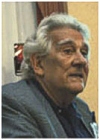
Filippo Conti
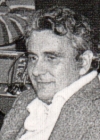
1976
| The demise of Filippo Conti
With a shock, I have received the news that Filippo Conti, a prominent Italian pioneer and promoter of Magnetic Resonance, has left us. He was a good friend of mine and dedicating him this mention is the least I can do.
I met Filippo in 1975 just after I started my job at Bruker Spectrospin Italiana. He was a newly named Professor of Chemical Physics at the University "La Sapienza" in Rome and one of the founding fathers of the Italian Gruppo Discussione Risonanze Magnetiche (now Gruppo Italiano di Risonanza Magnetica, or GIDRM). We have immediately become easy-going friends, despite my being a Czech and he decidedly "un Romano" (which, he would point out, is more than "un Italiano"). A year later, together with his friends from the Istituto Nazionale della Nutrizione (Claudia Lintas et al), we have got involved in the organization of the 1st School of NMR Applied to the Food Science and Technology (see the photo below). It was an event notable, among other things, for the fact that we had there an operative Bruker Minispec (20 MHz, low resolution) and the lecturers kept constantly discovering features of LR-NMR of cheese and the like whose existence they never suspected. We were all hard pressed to invent impromptu theories to explain to the students - and to ourselves - all the unexpected data. Filippo handled that cheerfully and masterfully!
After the School we kept collaborating for several years on NMR of foodstuffs. Initially, some students of his (Maurizio Paci, Alfredo Di Nola, Maurizio Delfini and, in particular, Elvino Brosio) were coming to the Bruker office in Milano to carry out measurements, until Filippo bought from "me" a wide-bore 90 MHz FT-NMR instrument (a real 5 ton monster) and a Minispec, and the experimental work moved to Rome to his new lab. It became my duty to go to Rome whenever he needed technical assistance or an ad-hoc accessory (he started a collaboration with a medical group on NMR of perfused live organs). I feel truly honored by the fact that I have co-signed with him and his band-boys (now respected Professors) several papers which can be still read without blushing (see
A,B,C,D,E).
Later we kept encountering each other at meetings, above all those of GIDRM. In the 80's he became a promoter of the European Society for Magnetic Resonance in Medicine and drifted ever more towards medical NMR applications. Recently he became very active - both scientifically and socially - also in the new field of NMR metabolomics (Italians, click here). With his demise, Italy is loosing an influential scientist and a capable NMR expert.
Prima Scuola: Risonanze Magnetiche Nucleari
applicate alla Scienza e Tecnologia degli Alimenti
Aosta, October 19-22, 1976
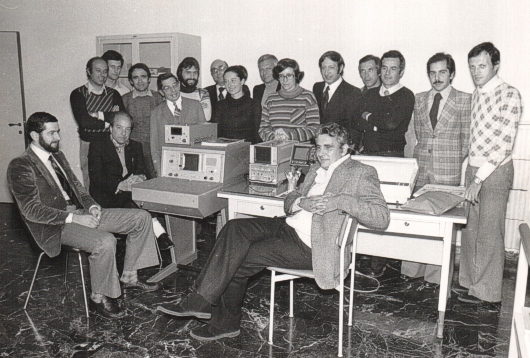
Sitting (from right to left): Filippo Conti, Luigi Conti (not a relative), and myself. Of those standing, I recognize Elvino Brosio (2nd from right, with moustache), Enzo Tiezzi (4th, he became a Member of Parliament), Claudia Lintas of the National Institute of Nutrition (6th) and Prof.Indovina of the Istituto Superiore di Sanità (4th from left). If anybody can help me to identify somebody else, I will be grateful.
|
May 31, 2009
Cutoffs from
NMR spectra
of ODCB
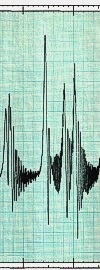
CW at 100 MHz
1975
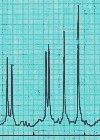
FT at 80 MHz
1980
LW = 0.07 Hz
(not achievable
today)
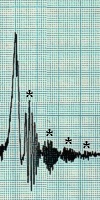
Wiggle beats
of an unresolved
doublet
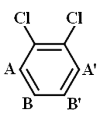
ODCB
The AA'BB' are
coupled protons
| FT versus CW: What we gained and what we lost
There is a widespread and more or less justified understanding that the passage from CW (continuous wave) to pulsed FT (Fourier transform) NMR spectroscopy was absolutely beneficial in terms of both sensitivity (S/N ratio) and spectral clarity (absence of wiggling artifacts). Though I more or less agree with this majority opinion, I want to cast some doubt about its universal validity. Indirectly, I also want to point out that the opinion is often most vehemently promoted by people who do not have a real grasp of the whole story.
First some history. From late 40's to late 60's, NMR was always acquired [1-4] in CW mode using a continuous RF irradiation by means of one tuned coil and a simultaneous, continuous RF detection by a second tuned coil, orthogonal to the first one. This was the crossed-coils arrangement, but the same result could be achieved using an RF bridge with a single tuned detection coil balanced by a matching circuit. Due to patent constraints (unlike today, back then patents still had an impact) the cross-coils arrangement was used by Varian and the bridge arrangement by Jeol, while Bruker was still in a pre-natal stage. The spectrum was "scanned" by varying linearly either the magnetic field (field-sweep mode) or, equivalently but less frequently, the RF frequency (frequency-sweep mode).
Already then, after the introduction of sample spinning [7] and magnetic-field shim coils [8], resolution was quite good and linewidths way below 1 Hz were achievable. The present day ubiquitous resolution specification of 0.4 Hz goes back to late 60's and in those 40+ years it never changed (indeed, in a sense, actual resolutions went through an optimum around 1980 and then worsened).
After 1966, the FT technique [10] started spreading due a number of concomitant factors, such as (i) the availability of mini-computers (incorporating a dedicated computer into a mere instrument was a truly revolutionary idea), (ii) the advent of the Cooley-Tukey [9] FFT algorithm (early mini-computers were incredibly inefficient and had very little memory), (iii) the fast growing interest in 13C NMR spectroscopy which, at natural abundance, is about 6000 times less sensitive than proton NMR, (iv) the realization that FT-NMR permits to reach in a given time interval a better signal-to-noise ratio (S/N) than CW-NMR, and (v) the need to boost S/N by data accumulation which is easier in FT than in CW.
Consequently, during the 70's there was a gradual drift from CW to FT instruments. Bruker, then a newcomer among NMR manufacturers, owes much of its initial success to the ability to rapidly exploit the FT revolution at an industrial and commercial level. Nevertheless, CW instruments like the Varian EM360 (60 MHz) and EM390 (90 MHz) and the Bruker WP80CW (80 MHz) maintained a dwindling market share until at least the late 80's. In 1984-85 I worked as an agent for Varian in Italy and received a special mention as the second EM360/390 salesman worldwide (the first one was their man in mainland China); I believe that I have sold five or six of them. The EM360 was the NMR instrument model which remained in production for the longest time (over 15 years) and it must have also broken all records in terms of total unit sales (? does somebody know how many ?).
Now we use exclusively FT-NMR, so an ODCB (ortho-dichlorobenzene) resolution test of a manually shimmed CW-NMR instrument is something very few today's NMR spectroscopy users have ever seen, much less actually made. For this reason, I publish here a CW ODCB spectrum acquired in January 1975 on a Varian HA-100 (100 MHz) at the University of Bari (you can click here to view/download a full-size image of the original).
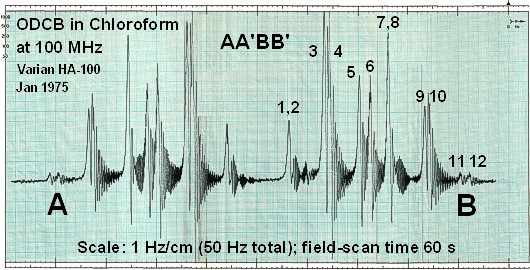
There are many things one can say about this spectrum. Some are just remarks on simple facts like the use of pre-calibrated paper (we use special software to achieve this kind of standardization today) and the horizontal-scale labeling in Hz rather than ppm. More importantly, the 1 minute scan of the 50 Hz is far too fast given the resolution of about 0.25 Hz, so we see all the [apparently] annoying wiggles [5,6]. However, for the gourmets, the wiggles were a god-send panacea. Notice the beats in the wiggles after peaks (1,2) and (7,8). They are due to the fact that the peaks, though unresolved, are actually doublets. An experienced NMR spectroscopist would have noticed them immediately and have no problem to derive the doublet splitting from the distance between the maxima of the beats. In this way we were able to detect splittings below 0.1 Hz! Today, some operators do not even know which peaks are the ones to be used to measure the linewidth (5 or 6).
What I lack most, however, is the sense of awe when one, spellbound, was looking at the recorder pen and, sure enough, at exactly the expected positions it started shooting up to the peak top and then fell down, noisily following the crazy wiggles, nearly stopping, but suddenly coming again to life as the next wiggle beat was coming out. No FT instrument has ever affected me in quite the same eery way! Yes, that was NMR! Also, one could stop the scan at the top of a line (i.e., a single transition of a quantum spin system) and keep it there indefinitely. But move it 0.2 Hz away and the signal will drop to zero. Think about this in terms of quantum physics, photon exchanges, and a Hamiltonian which is time-averaged over 50 kHz wide random fluctuations due to dipolar interactions and molecular tumbling. If you are a physicist, you should become dizzy. With the discussion about the true nature of NMR signals catching fire again [11-13], this appears to me eminently pertinent.
Finally, I want to make a comment about sensitivity. The scan above has taken 1 minute and that was too short; the operator should have scanned five times slower to make the spectrum artifact-free. While scanning, he has used a 5 Hz filter; if he scanned five times slower, he could have used 1 Hz filter and gained √5 in S/N - the usual time versus S/N dependence. If the same spectrum were acquired in FT mode, the FID would take about 4 s to completely ring down (4/(π*linewidth)). Apparently, that is quite a saving with respect to the 5 minutes of the CW scan - a factor of 75 in scan time. But FT requires the filters to be open enough to cover the whole spectral window, which implies a filter with 25 Hz frequency cutoff instead of 1 Hz - a factor of 25, but going in the opposite direction in terms of S/N. Moreover, to really exploit the FT scan-time advantage, one should repeat the FT scans for the whole 5 minutes required by the single CW scan. This, however, has its limits: the long relaxation times of this sample (T1 of about 30 s) command a relaxation delay of at least 2 minutes, lest the intensities (both relative and absolute) of the lines get distorted. So the FT advantage somehow does not look great at all in this case - it's actually barely equivalent.
It can be shown, in fact, that when both methods are optimized and NO spectral distortions are allowed, CW and FT techniques are equivalent, including sensitivity. Only when intensity distortions as large as 50% are allowed (such as in 13C spectroscopy) can one reach the claimed acquisition-time factors of 100 in favour of FT. A more modest advantage factor of 10 implies intensity distortions of about 10%, which is just what we find in most present-day proton spectra. As always, it is the same old story: you never get anything for free.
Notes: I got hold of the ageing spectral record shown above purely accidentally; very few such spectra survived until today (remember: the CW instruments had no computer and the spectra were directly plotted on paper using an analog recorder). I have myself measured many hundreds of CW test spectra but did not preserve a single one! If anybody still has such documents, it would be nice if he/she could scan them and share them with us (I would be glad to keep an online collection).
References:
- Purcell E.M., Torrey H.C., Pound R.V.,
Resonance Absorption by Nuclear Magnetic Moments in a Solid,
Phys.Rev. 69, 37-38 (1946).
DOI link
- Bloch F., Hansen W.W., Packard M.E.,
Nuclear induction,
Phys.Rev. 69, 127 (1946).
DOI link
- Bloch F., Hansen W.W., Packard M.E.,
The Nuclear Induction Experiment,
Phys.Rev. 70, 474-485 (1946).
DOI link
- Roberts A.,
Two New Methods for Detecting Nuclear Radiofrequency Resonance Absorption,
Rev.Sci.Instrum. 18, 845 (1947).
DOI link
- Roberts A.,
The Magnetic Moment of the Deuteron,
Phys.Rev. 72, 979-979 (1947).
DOI link
First observation of "wiggles" (he coined the term).
- Jacobsohn B.A., Wangsness R.K.,
Shapes of Nuclear Induction Signals,
Phys.Rev. 73, 942-946 (1948).
DOI link
Explanation of fast passage distortions (wiggles)
- Bloch F.,
Line-Narrowing by Macroscopic Motion,
Phys.Rev. 94, 496-497 (1954).
DOI link
This suggested sample spinning and led to the most successful NMR patent ever.
- Golay M.J.E.,
Field Homogenizing Coils for Nuclear Spin Resonance Instrumentation,
Rev.Sci.Instruments 29, 313 (1958).
DOI link
Introduction of shim coils. Marcel Golay was a mathematician at Perkin-Elmer.
- Cooley J.W., Tukey J.W.,
An Algorithm for the Machine Calculation of Complex Fourier Series,
Math.Comput. 19, 297 (1965).
- Ernst R.R., Anderson W.A.,
Application of Fourier Transform Spectroscopy to Magnetic Resonance,
Rev.Sci.Instruments 37, 93 (1966).
DOI link
- Hoult D.I., Bhakar B.,
NMR signal reception: Virtual photons and coherent spontaneous emission,
Concepts Magn. Reson. 9, 277-297 (1997). DOI link
- Hoult D.I., Ginsberg N.S.,
The quantum origins of the free induction decay and spin noise,
J.Magn.Reson. 148, 182-199 (2001).
DOI link
- Sykora S.,
Spin Radiation, remote MR Spectroscopy, and MR Astronomy,
Talk at 50th ENC, Asilomar, March 29 - April 3, 2009.
COMMENTS:
4 June 2009: Stan
A reader pointed out that I should compare filter bandwidths rather than cutoff frequencies. True enough, but I am not sure about the original CW filter settings in "Hz"; I think that, the way it was defined and measured, it was akin to cutoff frequency. The estimated ratio (25) of filter settings is in any case approximate, because the filter types are quite different. It is the qualitative argument that matters, not the exact numbers.
|
May 15, 2009

STELAR
VTC remote control
Application
DOWNLOAD
new VTC driver:
use the Save option
| Corrected Stelar VTC driver
A User of one of the Stelar FFC (Fast-Field-Cycling) variable-field NMR relaxometers has recently discovered a bug in the driver of the optional remote-control accessory for the VTC90 or VTC91 variable temperature unit. Since the bug is an old fault of mine for which I feel responsible even though I am no longer with Stelar, I have corrected it (with the User's valuable help) and I am making it available for a free download. The driver's file name is still Vtc90.dll, but its Version (listed in file properties) is 1.1.0.6. It should replace the file with the same name in your AcqNMR software directory (no installation is needed, just save the new file in the Directory). The bug in the old version did not allow the driver to recognize the VTC unit's status when the sample temperature was inside certain numeric intervals and therefore prevented remote temperature setting and reliable automation.
I want to use this occasion to point out that Tomaz Apih and his co-workers in the Robert Blinc's NMR Group in Ljubljana (Slovenia) have written a number of useful VT-automation macros for the Stelar instruments they use and they are willing to share them with others. If you are interested, please e-mail Tomaz (btw: now you know who hunts my ageing bugs :-)
Note:
To know whether your VTC is interfaced to the AcqNMR program, look at the parameters page Acq.pars|Conf. If you find there the parameters VTCT and VTCD and, setting VTCT to "VTC91", manage to enable a VTC monitor panel in the right part of the top status bar which mimics the VTC unit's display, then you should go for the new driver.
|
May 13, 2009
Amazon links:
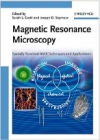
S. Codd,
J.D. Seymour,
Editors
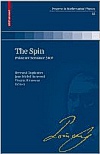
B. Duplantier,
J-M. Raimond,
V. Rivasseau,
Editors
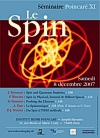
Bourbaphy
| A couple of interesting new MR books
There are two MR-related books which have just left the presses and definitely caught my attention. Both are edited collections of contributors from many authors:
Magnetic Resonance Microscopy: Spatially Resolved NMR Techniques and Applications,
edited by Sarah Codd and Joseph D. Seymour and published by Wiley-VCH.
As it sometimes happens in edited collections, the title of this book does not make justice to its contents which are much broader. It is primarily a methodological book dealing with an amazing sequence of very novel NMR and MRI techniques viewed from various engineering, physical, bio-physical and physico-chemical perspectives. Its Table of Contents, with 31 essays grouped into 6 Sections exposes its nature better than any verbose description. It looks somewhat like a complete ENC Conference program and explains why I did not regret the rather steep price tag to buy it.
The Spin: Poincaré Seminar 2007, edited by Bertrand Duplantier,
Jean-Michel Raimond and Vincent Rivasseau,
and published by Birkhäuser (Basel).
This book is a resumé of the XIth Poincaré Seminar (December 2007) which was totally dedicated to the concept of spin and its applications. The quasi-periodic event is also jokingly known as Séminaire Bourbaphy, a physics version of the Séminaire Bourbaki in mathematics. The six essays presented at this particular meeting are, like all Bourbaphy texts, freely available online as PDF files so you do not need to buy the printed book unless you want to keep it under your cushion at night.
I have enjoyed a lot the opening essay by Jürg Frölich entitled Spin or, Actually: Spin and Quantum Statistics. The Author first lists the areas of science and technology where spin plays a major role and is refreshingly frank in admitting how poorly we understand most of them. What has hurt me a bit, however, is his comment about magnetic spin-resonance (page 3) which appears to be one of the very few phenomena he feels real comfortable with:
The fact that electrons and nuclei have spin and magnetic dipole moments which can precess is at the basis of Bloch's spin-resonance phenomenon, which has breathtakingly important applications in the science and technology of imaging; (Nobel Prizes for Felix Bloch, Richard Ernst and Kurt Wüthrich). Of course, in this case, the basic theory is simple and well understood.
Good for Jürg, since after 40+ years in the field I am still not at all sure whether I understand it! The second Section of Jürg's treatise (pages 5-13) is perhaps the most concise, complete, and down-to-the-basics history of the discovery of spin and spin-related quantum statistics I have ever read. Today some of us tend to forget all the intricate phenomena that needed a coherent explanation and forced quantum mechanics upon our spinning heads!
Another great MR treatise in this collection is that of Pierre-Jean Nacher, entitled Magnetic Resonance Imaging: From Spin Physics to Medical Diagnosis which is actually a great tutorial review dedicated to the use of hyper-polarized 3He and 129Xe in MRI.
Note:
For additional reading about the history of spin in physics, I recommend the 1998 book by Sin-Itiro Tomonaga, The Story of Spin.
To learn more about modern non-MR applications of spin, instead, a good choice is Spintronics, edited by T. Dietl at al.
|
May 12, 2009
| A new NMR blog
Mestrelab Research, a Spanish Company and the leading producer of NMR spectroscopy software (Mnova), has started a Company blog which is extremely readable. The most recent items sound like a travel diary, kind of tracking the footsteps of Marco Polo.
Since I am personally connected with the Mestrelab team but, at the same time, do not want this e-zine to be tagged as a company blog, I am not going to tell you more. Just have a look at their new pages and enjoy Santi Dominguez' account of his voyage through China.
By the way, Carlos Cobas, Mestrelab's President and top scientist, assures me that he will continue his personal blog dedicated to NMR Analysis, Processing and Prediction and keep it even more scientifically and technically oriented than before. Which brings my list of NMR blogs of general interest to a full dozen.
|
May 10, 2009
See the UPDATE
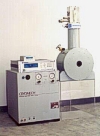
1999: 1st CFSM
(Cryomagnetics)
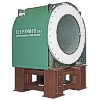
1.6 T MRI CFSM
(Jastec)
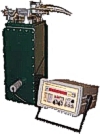
100 MHz CFSM
40 kg benchtop
5 ppm resolution
(Cryogenic)
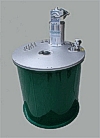
CFSM ESR magnet
(Cryogenic)
| Magnetic Resonance and cryogen-free superconductor magnets
The term cryogen-free superconductor magnet (CFSM) refers to devices which do not employ any liquefied gases such as helium and nitrogen. The advent of this new category is - or rather was - a logical step in the evolution of the insulating dewar container of the classical "supercon". As liquid helium and nitrogen consumption kept steadily decreasing, a moment had to come when the heat which needs to be removed can be handled actively by means of incorporated heat pumps, rather than passively by cry-gases liquefied off the premises and transported around the Country in insulated vessels (to think of it, this is a bit absurd).
Cryogen-free magnets are manufactured and commercialized by at least four Companies (Cryomagnetics, Jastec, Cryogenic and HTS-110: see the References) and the technology is actively monitored by all major producers of magnetic resonance hardware. Among major NMR spectrometer manufacturers, Bruker and Varian are either behind or (more probably) holding back on information, while Jeol appears to be ahead due to a wide range of cryogen-free magnet models offered off-the-shelf by Jastec, Jeol's magnets sub-supplier.
What I find interesting is that the smaller Companies (Cryomagnetics, Cryogenic and HTS-110) are all actively exploring the potential NMR and ESR applications of CFSM's. One (HTS-110) is even offering a simple table-top FT-NMR spectrometer.
Presently, the available cryogen-free magnets reach very respectable fields of 18 Tesla (over 760 MHz) and keep crawling upwards, but their field homogeneity is a bit too low for high-resolution NMR applications. The latter drawback, however, is hardly essential since there is no basic obstacle to the addition of supercon- and room temperature field shims.
How is a cryogen-free supercon magnet operated in practice? Simple: imagine that you throw a switch and wait a few hours (or a few days, depending upon the size of the magnet) until the device cools down. During this period the cooling systems run at full power of 1-7 kW (again depending upon the size). Afterwards, the power required to keep the device cool is much lower - somewhere in the category of a pressing iron! The next step is the energization which is much like what one does today. The magnet can be energized, typically in a matter of 0.1-4 hours, to any field up to its nominal maximum.
The cryogen-free superconductor magnet technology will eliminate the dependence of MR on the uncertain future of the helium supply. It should also help to bring MRI and high-field NMR to developing Countries where MR is all but unknown due to the lack of liquid-helium distribution infrastructures (it might even alleviate the seemingly incurable gap between the availability of MRI in developing and developed Countries). Finally, it provides a more manageable access to high magnetic fields in those contexts where the magnet is needed only sporadically and/or operated at variable field strengths (a frequent case in physics laboratories and in non-MR applications).
For these reasons, I would expect the CFSM technology to become dominant in a decade or two, making objects like liquid helium transfer lines a memory of the past.
Links and References:
- Companies concerned with magnet systems and magnetic fields (a Directory).
- Cryomagnetics Inc in Oak Ridge, Tennessee, USA.
They were the pioneers in this area. See the list of their cryogen free systems.
- Cryoconcept in Courtaboeuf, France, now owned by Cryomagnetics.
They are dewar and refrigerator experts. Have a look at this impressive brochure.
- Jastec Superconductor Incorporated Inc in Tokyo, Japan, is a sub-supplier of supercon magnets for Jeol.
See their impressive list of cryogen free systems.
- Cryogenic Ltd in London, UK, has an interesting catalogue of cryogen free systems.
They start looking at NMR and ESR.
- Good J., Mitchell R., of Cryogenic Ltd,
A Desktop Cryogen Free Magnet for NMR and ESR,
IEEE Transactions on Applied Superconductivity, 16, 1328-1329 (2006). DOI: 10.1109/TASC.2006.871292
- HTS-110 Magnetic Solutions in Wellington, New Zealand.
This Company exploits high temperature superconducting (HTS) wire and cryogen-free refrigeration systems for a number of applications. Unlike the other Companies, they do not use low-temperature superconductors which is both a limitation (low current density) and an advantage (less demanding cooling requirements).
See their HTS-NMR page.
- Bruker Advanced Supercon provides superconductors for Bruker Corporation, but the only mention of cryogen-free magnets on their site regards HTS leads for CFSM coils.
- Magnex in Yarnton, UK, is a supercon magnets producer now totally owned by Varian, Palo Alto (CA), USA.
I could not find any mention of cryogen-free magnets on their site.
- ICE - Innovative Cryogenic Engineering in Oxford, UK.
This Company applies advanced cryogen-free cooling techology to sample-temperature controllers for spectroscopy and other applications, but they do not produce magnets.
|
April 30, 2009
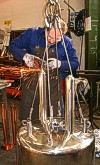
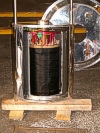
Photo V. Piccinotti
| Disposing of superconductor magnets
What does one do with discarded, broken superconductor magnets? Does it make sense to repair them, maybe combining two or three broken units to make a single working one? Are there any recycling facilities willing to pay for them - or even just to accept them? Are the superconducting wires reusable? Are the alloys they contain environment-friendly? These are not easy questions to answer (apparently, the answers to all of them are negative).
The fact is that sooner or later somebody will have to address this problem.
Combining MRI, HR-NMR and other applications, there are some 50'000 superconducting magnets in operation around the world. The second law of social thermodynamics tell us that, sooner or later, every man-made product becomes garbage and supercon magnets are certainly no exception (nor are space stations and nuclear warheads). The future garbage disposal should be built into a product already in its design stage, which is not what happened, nor is happening with supercons (manufacturers, would you comment?)
One of the few known uses of discarded superconducting magnets, at least the smaller ones chemists use for HR-NMR spectroscopy, is as pieces of techno-art to exhibit in the foyers of technical Institutions or to use as interior decorations. This usually involves cutting out "windows" through the metal dewars and partially exposing the inner parts, including the superconducting coil.
In case you have something like that in mind, Ing. Vanni Piccinotti in Florence (Italy) has a couple of dismantled supercon magnets and can give them away almost at junkyard cost. If you are interested, write directly to him.
|
April 29, 2009

ENC 2009
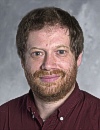
and its Chair,
Lucio Frydman
Asilomar grounds,
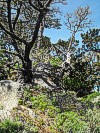
flora,

and fauna.
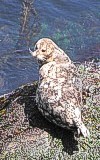
Asilomar photos
by Lucia Parretti
My own
crazy Talk:
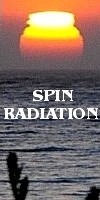
and a
serious Poster:
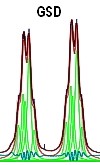
| Glimpses of the 50th ENC
The anniversary 50th ENC (Experimental NMR Conference), which I had the privilege to attend, is now over since almost a month and it is time to collect my impressions before they start fading away. As usual, and unavoidable, my comments and my choice of topics are strictly personal; it would be totally impossible for any single person to significantly comment on all aspects of a meeting of about 1100 motivated attendees which included 7 plenary Sessions (of which one historic carrousel and one futuristic escapade), 13 split Sessions (7+6), one Tutorial Session, 92 oral presentations, 516 posters and several side-meetings, and which involved in one way or another almost 2500 listed Authors. I doubt, in fact, whether I can add any meaningful insight at all to an event which, under the impeccable chairmanship of Lucio Frydman, was a fitting culmination of 50 years of ENC history (in other words, you either were there or you were not, tertium non datur). Nevertheless, let me try.
My first comments regard organization and, since not all of them are positive, I hope that they will not be the cause of my permanent disbarment from future ENC's. On the positive side I list first of all the fabulous environment and the overall concept of Asilomar. Making a congregation of over a thousand people live and work for a week unobtrusively in wooden lodges under a pine forest, without creating any bottlenecks and apparently not even disturbing the natural habitat, is a feat for which I do not have any adequate adjectives of praise. I am also sure that everybody liked the hospitality suites which make out-of-premises dinners unnecessary and permit the participants to confer informally until late night. This de facto amounts to doubling the "useful conference time" of the participants. The organization of the meeting as such was also very smooth; as one of its lowest-level beneficiaries, I felt fully satisfied and I did not hear a single disgruntled comment from other participants. On the negative side I would list the catering service (lunches and coffee breaks). They were as good as last year which, by Italian-Czech standards, is not quite good enough. I have resorted to the close-by services of the Mexican FishWife restaurant, complemented by the Italian Cafe run by my ex-partner Gianni Ferrante at the STELAR stand in the posters hall.
My second series of comments regards the contents of the meeting. These can not be but enthusiastic since ENC is definitely my kind of conference. It concentrates on Magnetic Resonance as such, meaning MR principles, technology, techniques and methodology, rather than "mere" MR applications. A good example of what I mean is the Günther Laukien prize which was awarded this year to Daniel Weitekamp for his PASADENA and BOOMERANG methods. These regard two different MR areas (hyperpolarization by para-hydrogen and magnetic-force-microscopy, respectively) and they are both likely to reach an untold number of specific applications. However, it is not the applications which are being honored, but the basic principles of the methods themselves.
In MR we are used to a ceaseless spawning of new ideas, methods and devices, and ENC is the forum of choice where to announce such advances. True to this tradition, there were quite a few presentations and posters introducing novel ideas and items such as travelling-wave MR, various NMR-on-a-chip approaches, harbingers of portable high-resolution permanent magnets, and others. On the other hand, I have missed some items which I would have expected, such as cryogen-free superconductor magnets. But there is no way I can dwell on such specific points in a brief summary like this one. Nor can I comment in detail the individual Sessions and much less any individual presentations. The Conference program as well as all the abstracts are available on the ENC web site where you will soon find also the slides of the three Tutorial Lectures (starting from 2006, the slides of all ENC Tutorial Lectures remain permanently available and represent a very useful online educational resource). By the way, the ENC web site is probably the best and the most user-friendly one I have ever seen. Congratulations to the webmaster!
My third and last series of comments concerns the historical and futurological aspects of this anniversary meeting. There was an afternoon Historic Session (a carrousel of eminent NMR personalities sharing their reminiscences), a Historic Exhibit with old photos and pieces of equipment, and what one might call a Futuristic Session (including, for example, a blueprint for instant quantum transportation by Anton Zeilinger). Plus a Walk of Fame flanked by a named star for each of the 50 persons who have Chaired the meeting so far. Plus an amazing VARIAN evening of historic recollections at their Suite, attended by now legendary Varian NMR retirees like Martin Packard, Weston Anderson and Jim Shoolery.
It was all fabulous to the point of being intoxicating ...
I would like to add a couple of statistics which I find a bit intriguing.
Poster categories, sorted by number of posters in each:
49 Solution NMR Studies of Proteins and Nucleic Acids
48 Solid State NMR of Small Molecules and Materials
43 Biomolecular Solid State NMR
42 Hyperpolarized and Enhanced-Sensitivity NMR
39 Magnetic Resonance Imaging
39 Small Molecule Solution NMR
35 Relaxation and Dynamics
29 Membranes and Membrane Proteins
29 Methodological Developments in Solids NMR
29 Instrumentation
20 New Data Processing and Software Developments
19 Biomolecular Solution NMR (other than proteins and nucleic acids)
19 Metabolomics
19 Exotic Aspects of Solution and Solid State NMR
21 Ligand Binding and Bio-Molecular Complexes
12 in vivo Spectroscopy
10 Screening and Drug Development by NMR
7 From NMR Data to Biomolecular Structures
5 Education/Facilities
2 Industrial and Process NMR
These poster population statistics do not appear to be completely in line with the accent given to each topic in the presentations. Evidently, there is a significant difference between what people really do (the posters) and what they think about (the presentations).
Presentations, sorted by the State affiliation of the presenting speaker:
49 USA, of which 10 CA, 7 MD, 5 MA, two each AZ, IN, NY, PA, VA, and one each
AK, CT, FL, GA, IA, IL, MO, MS, NC, NJ, OK, OR, SC, TN, TX, UT, WA
26 Europe, of which 10 UK, 4 Germany, 3 France, 3 Switzerland, 2 Netherlands,
and one each for Sweden, Spain, Italy and Belgium
6 Canada
3 Japan
2 Israel
These confirm the fact that Magnetic Resonance is a privileged area of the first-world. Maybe we should start reserving a quota to the rest of the world, but it would not be easy since there are also huge internal differences within USA and within Europe.
|
April 10, 2009
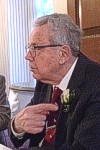
Aksel Bothner-By
26 March 2009
Click above for
more pictures
| Honors to Aksel A.Bothner-By
Time is running fast and I am still putting together my glimpses of the 50th ENC meeting which is now one week past. Before that, however, I want to publish the comments of my friend Roberto Gil on a special Symposium in honor of Professor Emeritus Aksel A. Bothner-By which took place at Carnegie Mellon University in Pittsburg a week before the ENC. As every senior NMR spectroscopist knows, Aksel is one of the foremost pioneers of NMR chemical applications and the symposium was an opportunity to bring together some of the fathers of the technique.
As Director of the NMR Facility at the Chemistry Department of CMU, Roberto was much involved in the organization of the event. Here is what he wrote me after the first day:
Things went very well during the first half day of the Symposium honoring Aksel, who came with his wife Christine. Aksel is 88 years old !!!
We have started with a brief introduction by me and a few opening remarks by our Vice-President for Research, Prof. Richard McCullough, who mentioned that he was hired by Aksel as an assistant professor, since at that time Aksel was the Department Head. Then we had a historical interlude, nicknamed by Joe Dadok the Senior's Section. Joe called the Seniors one by one to talk for about 10 minutes each. Joe started it and was followed by John Delayre, Chien Ho, Tony Keller, John Markley, Brian Sykes, John Waugh and Dieter Ziessow. After the talks and a coffee break all the Seniors came up to the stage of the Mellon Institute Auditorium for a group picture, followed by questions from the audience.
Since Martin Packard, Wes Anderson, Jim Shoolery and Alex Pines could not be with us, they sent videos that we showed after the historical session. It was wonderful.
We have finalized the Thursday sessions with three scientific talks by James Prestegard, Peter van Zijl and Alfred Redfield. Redfield presented recent results of his work on Field Cycling High Resolution Relaxometry.
At 5:30 pm we had a reception for all attendees in the Mellon Institute Social Room where we drank a selection of Argentine wines (Cabernet Sauvignon, Malbec and Torrontes). This was followed by a dinner at the Pittsburgh Athletic Association ...
Then, on April 7, followed the rest:
... As I mentioned in my previous message, Thursday evening we gathered for dinner at the Pittsburgh Athletic Association. The NMR community gave Aksel a nice present (see the picture). We resumed the symposium on Friday morning with a continental breakfast, followed by a series of scientific talks by Ad Bax, Christian Griesinger, John Markley, Angela Gronenborn, Nico Tjandra, Brian Sykes and Denis Markiewicz. Aksel showed up for the last talk and the closing remarks by Joe Dadok and me, and joined us for an informal lunch with boxed lunches.
It was a wonderful event. Aksel was so happy !!!
During this lunch I took a picture of Aksel holding a drawing of a spinning camel representing the CAMELSPIN experiment and a picture of his wife Christine doing the real camelspin skate figure.
There is little to add, except that the only talk with an explicitly mentioned content is the one by Alfred Redfield on FFC relaxometry. Clearly, Roberto must have been impressed by it ...
Click the picture on the left to see four full size photos taken by Roberto.
|
April 06, 2009

| Spin Radiation, remote MR Spectroscopy, and MR Astronomy
Many people have asked me the slides of my recent talk at the 50th ENC meeting. It is with pleasure that I make them available (follow the link or click the spin radiation logo on the left). The slides by themselves are not the same thing as a presentation and, vice versa, neither the long abstract, nor a few minutes presentation can render justice to the full information present in the slides. I therefore hope that both the abstract and the slides will generate a thread of comments and discussions.
Note added on May 4:
I have started receiving comments and realized three things:
1) For some reason, many of my outgoing e-mails (in particular those to Californian Institutions) get bounced back by receiver-side servers (Italian internet providers must have a very bad reputation). I apologize to those who wrote me and did not receive any answer from me yet, but it is not my fault; I just can't reach you.
2) The volume of comments I should/would like to make in order to explain the slides is quite large and I should do so in a systematic way.
3) The discussion might go on for a long time and become quite voluminous.
I will therefore write an expanded commentary on the talk slides, doing it as if I had unlimited time for their presentation rather than just 15 minutes. I will also complement the commentary with proper references and links. This will take a few days, but I will do it in steps and keep posting whatever has been already finished on the talk page. Moreover, I am instituting a spin radiation index page which will contain the discussion and all internal and external links pertinent to the spin radiation topic.
|
|
Archive
| For a complete list of all entries since 2005, see the running INDEX
|
|
Visitor # 
ADVERTISE with us
NMR, MRI, ESR, NQR
Companies
Societies
Centres & Groups
Journals & Blogs
References
Free Texts
History
Links
BOOKS Lists
MATH | SOFTWARE
PHYSICS | CHEMISTRY
ELECTRONICS | DSP
WWW | Patents & IP
SPECTROSCOPY
MRI | NMR | ESR
Instruments
ARTICLES
Biography of F.C.Yu
Hebel-Slichter effect
MR Antenna Theorem
NMR Dead Time
One-Page MR Primer
K-space and MRI
S/N Perspectives
OTHER
SI Units &
Dimensions
Physics constants
Science Links

Support this site!
SHOP from here:
COMPUTERS:
Deals
Bestsellers
Accessories
Calculators
This page is
SPONSORED by:


Random offers:
|